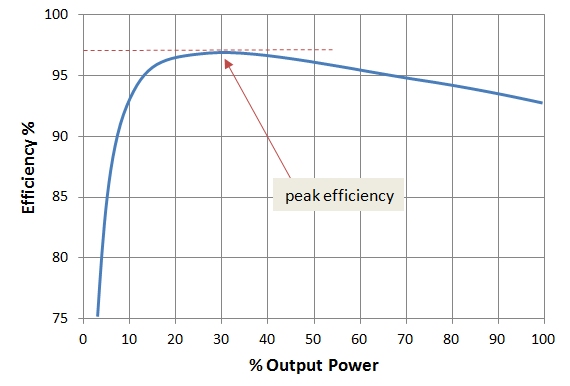6.5. Efficiency of Inverters
The efficiency of an inverter indicates how much DC power is converted to AC power. Some of the power can be lost as heat, and also some stand-by power is consumed for keeping the inverter in powered mode. The general efficiency formula is:
where PAC is AC power output in watts and PDC is DC power input in watts.
High quality sine wave inverters are rated at 90-95% efficiency. Lower quality modified sine wave inverters are less efficient - 75-85%. High frequency inverters are usually more efficient than low-frequency.
Inverter efficiency depends on inverter load.

Figure 11.8. Typical generic inverter efficiency curve. Below 10-15% of power output, efficiency is quite low. At high output power, the efficiency is steadily high with some small variations.
The behavior in Figure 11.8 partially results from the fact that stand-by losses for an inverter are the same for all output power levels, so the efficiency at lower outputs is affected more.
There are three types of efficiency ranking used for inverters. You may come across those numbers as you research different models and manufacturers. Those three types are:
- Peak efficiency (shown by arrow in Figure 11.8) indicates the performance of the inverter at the optimal power output. It shows the maximum point for a particular inverter and can be used as a criterion of its quality.
- European efficiency is the weighted number taking into account how often the inverter will operate at different power outputs. It is sometimes more useful than peak efficiency, as it shows how the inverter performs at different output levels during a solar day.
- California Energy Commission (CEC) efficiency is also a weighed efficiency, similar to the European efficiency, but it uses different assumptions on weighing factors.
The main difference between the European and CEC efficiencies is that the assumptions about the importance of each power levels for a particular inverter are based on the data for Central Europe in the former case, and California in the latter. Hence, different formulae are used to calculate those values:
These methods of calculations need to be taken into account when using inverter specifications (Martin, 2011).
To learn more details about inverter efficiency, please go to the following reading.
Reading Assignment
Book chapter: Mertens, K and Hanser K.F., Photovoltaics: Fundamentals, Technology and Practice, Chapter 7, Section 7.2.4 Efficiency of Inverters, pp. 177-181.
Please answer the following self-check questions based on the above material.
Check Your Understanding
Question 1
What is the efficiency of an inverter that outputs 2000 W of AC power using an input of 2200 W of DC power?
Question 2
Question 3
See if you can estimate the European efficiency for an inverter that has the following efficiency curve data: at 5% power output η=85%, at 10% η=91%, at 20% - η=96%, at 30% η=97%, at 50% η=96%, and at 100% power η=95%. Input your value below, compare with the answer.
